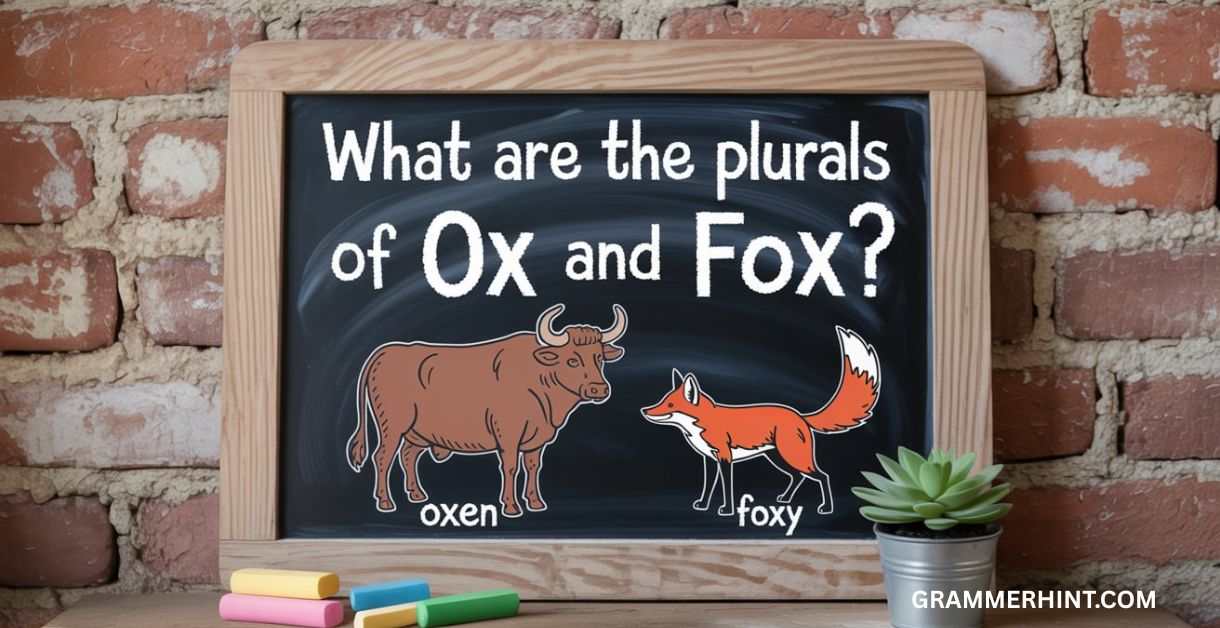English can be quirky, especially when it comes to pluralization. If you’ve ever paused to wonder about the plural of ox or the plural of fox, you’re not alone.
Why do we say oxen but not foxen? And why is the fox plural form simply foxes? Let’s dive into the fascinating world of English noun pluralization, exploring the history of English plurals, irregular plural nouns, and some handy grammar tips for plurals.
Understanding Singular and Plural Forms in English
Before we zoom in on ox and fox, it’s important to grasp the basics of singular and plural forms. Most English nouns form the plural by adding -s or -es — for example, cat becomes cats, and box becomes boxes.
This rule works well for regular plurals, but English also has plenty of exceptions. These irregular plurals come from deep roots in Old English and sometimes even earlier languages. Words like child become children, man becomes men, and yes, ox becomes oxen.
The Ox: A Classic Example of Irregular Plurals
Ox Ka Plural — Why Is It Oxen?
The ox plural word isn’t oxes it’s oxen. This form dates back to Old English, where many nouns formed plurals by adding -en rather than -s. This pattern was quite common, especially with strong masculine nouns.
The oxen plural is one of the few remnants of this older system still alive in modern English. So, when you see oxen, know that it’s an irregular plural noun with historical roots, not a typo or an oddity.
Ox vs. Oxes: Why Not Oxes?
In contrast, the plural oxes feels awkward to native speakers because it goes against these old English plural rules. Over time, most nouns abandoned the -en ending in favor of -s or -es, but ox stubbornly kept its traditional form.
Think of it like a family heirloom in the language passed down from the cow family animal classification and preserved through centuries of language evolution.
Fox: A Regular Plural, But With a Twist
Fox Ka Plural — Why Is It Foxes?
Unlike ox, the word fox follows the more straightforward plural rules in English. Because fox ends with a -x, its plural form adds -es, making foxes.
This happens because words ending in s, x, z, ch, or sh usually form plurals by adding -es. It keeps pronunciation smooth, avoiding awkward clusters.
Fox vs. Ox Grammar: Why the Difference?

You might wonder why foxes plural form is simple and regular, while oxen feels like a curveball. The answer lies in historical linguistics and morphological variations.
- Fox comes from a line of words that shifted toward the modern plural system early on.
- Ox kept its original -en suffix, preserved as a rare exception in today’s English grammar quirks.
This contrast illustrates how language evolution rarely follows a straight path, especially when it comes to animal names.
Historical Grammar and Old English Plural Forms
To understand these differences better, we need a quick look into Old English. Back then, plurals formed in several ways, including:
- Adding -en (like oxen, children)
- Changing the vowel (like man to men)
- Adding -s (like books)
Most nouns have since settled on the -s/-es pattern, but some stubborn exceptions remain.
Morphology and English Word Origins Behind Oxen and Foxes
Morphology the study of word forms — explains why these plural forms exist. The ox plural form is a throwback to the time when nouns had multiple pluralization methods.
Meanwhile, the fox plural word simply follows the English plural rules developed after the Norman Conquest, which pushed many words toward the more uniform -s/-es endings.
Practical Examples: Using Oxen and Foxes in Everyday Writing
Let’s make this more tangible. Here are some sample emails and conversations where knowing the correct plural is key.
Example 1: An Email to a Farm Manager
Subject: Update on the Oxen Health Check
Hi Linda,
Just wanted to let you know the oxen arrived safely and seem healthy. The veterinarian checked all three and didn’t spot any issues. Please make sure the feeding schedule is updated to reflect the new arrival.
Also, could you confirm the number of foxes spotted near the storage barn last night? We want to ensure they don’t disturb the livestock.
Thanks,
Mark
Example 2: A Message Between Wildlife Enthusiasts
Hey Sarah,
I saw a pair of foxes in the park yesterday—beautiful creatures from the canine family creature group! It reminded me how different their plural is compared to oxen.
Funny how English language exceptions like these keep things interesting.
Cheers,
James
Irregular Plurals in Animal Names: Not Just Oxen and Foxes
These two aren’t alone. The English language features plenty of irregular animal plurals:
| Animal Name | Singular | Plural (Regular) | Plural (Irregular) |
|---|---|---|---|
| Ox | Ox | Oxes (wrong) | Oxen |
| Fox | Fox | Foxes | Foxen (wrong) |
| Sheep | Sheep | Sheep | — |
| Fish | Fish | Fish / Fishes | — |
| Squid | Squid | Squids / Squid | — |
Notice squid in the table. Like fish, it can have multiple plural forms. This is a good reminder that pluralization/plural forms often depend on context and tradition.
Why Some English Words Have Unusual Plurals
English has borrowed from many languages over centuries. This melting pot creates exceptions that don’t always follow modern plural rules in English.
- Words from Old English like oxen hang onto their traditional forms.
- Other nouns adapt to the regular and irregular plurals rules shaped by history and usage.
This patchwork leads to the kind of strange English plurals that keep linguists intrigued and language learners scratching their heads.
Grammar Explanation for Oxen and Foxes

To sum it up:
- Use oxen as the correct plural of ox because of its old English plural forms and its status as an irregular plural noun.
- Use foxes as the fox plural form following the modern English plural rules that add -es to words ending with -x.
- Don’t use oxes or foxen; these forms aren’t accepted in English grammar.
Summary Table: Oxen vs. Foxes
| Word | Singular | Plural | Explanation |
|---|---|---|---|
| Ox | Ox | Oxen | Old English, irregular plural |
| Fox | Fox | Foxes | Regular plural adding -es |
Final Thoughts on English Plural Rules and Language Evolution
The story of oxen and foxes is more than just a grammar lesson. It’s a glimpse into how the English language changes over time, influenced by historical linguistics, morphology, and cultural shifts.
Whether you’re writing an email, a story, or just chatting, knowing the plural of animal names like these shows your command of English grammar quirks. Plus, it’s a fun way to connect with the rich history behind the words we use every day.









